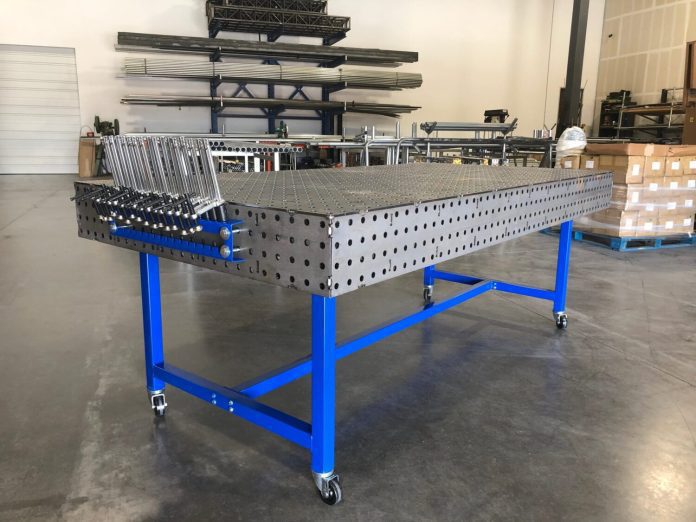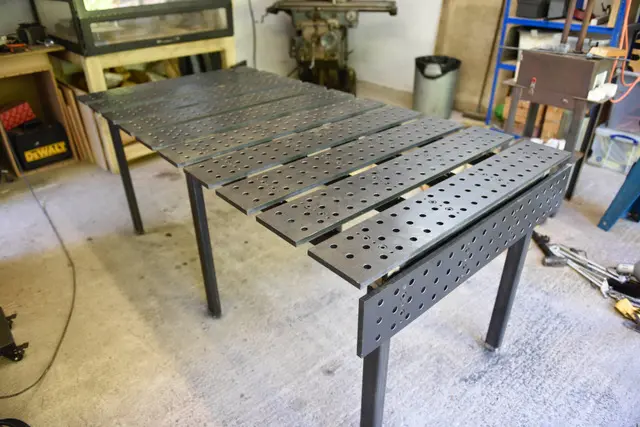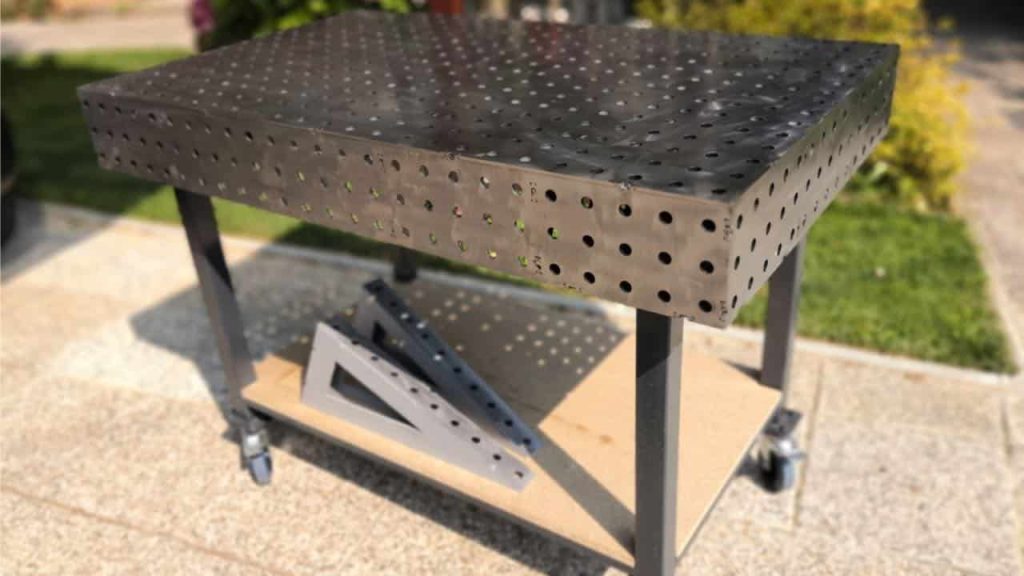Are you a welding enthusiast looking for the perfect welding table to enhance your projects? We understand the importance of finding the right surface to work on, as it directly affects the quality and precision of your welding. In this article, we will guide you through the process of choosing the ideal welding table that suits your specific needs and requirements. From considering the material, size, and weight capacity to evaluating additional features, we’ve got you covered. So, let’s dive into the world of welding tables and discover the key factors to consider when making this crucial decision.
This image is property of fractory.com.
Factors to Consider When Choosing a Welding Table
Choosing the right welding table is crucial for ensuring the success and efficiency of your welding projects. There are several factors that you should take into consideration before making a decision. In this article, we will explore the key factors that you should consider when choosing a welding table, including table size, material, surface flatness, weight capacity, table height, portability, adjustability, clamping mechanism, accessories, and price. By understanding these factors and their importance, you will be able to make an informed choice and select a welding table that meets your specific needs and requirements.
Table Size
One of the primary factors to consider when choosing a welding table is its size. The size of the table should be determined based on your specific projects and the workspace available to you. A larger table provides more surface area to work on, allowing you to handle larger materials and complete complex welding tasks. On the other hand, a smaller table may be more suitable if you have limited space or if you primarily work on smaller projects.
Material
The material of the welding table is another crucial factor to consider. The most common materials used for welding tables are steel, aluminum, and cast iron. Each material has its own advantages and disadvantages, so it is important to understand their properties before making a decision.
Steel welding tables are known for their strength and durability. They can withstand heavy loads and provide a stable work surface. Aluminum welding tables, on the other hand, are lightweight and easy to move around. They are also resistant to corrosion and have good heat dissipation properties. Cast iron welding tables are extremely durable and can handle high temperatures without warping. They are ideal for heavy-duty welding applications.
Surface Flatness
The flatness of the welding table’s surface is a vital consideration. A flat surface is essential for ensuring accurate and precise welds. It provides a stable and uniform work area, allowing you to properly align and clamp your materials. Before purchasing a welding table, it is important to check its surface flatness. You can do this by using a straight edge or a precision straightedge tool.
Weight Capacity
The weight capacity of the welding table is another important factor to consider. The table should be able to support the weight of the materials you will be working with, as well as any additional equipment or tools. It is crucial to determine the maximum weight capacity of the table and ensure that it meets your project requirements. Overloading a welding table can lead to instability and compromise the quality of your welds.
Table Height
The table height plays a significant role in ensuring ergonomic comfort during welding tasks. Working at a proper height can help prevent back and neck strain, allowing you to work efficiently and comfortably. The ideal table height varies depending on your own height and preferences. Some welding tables offer adjustable height features, allowing you to customize the table to your specific needs.
Portability
If you work on different job sites or require mobility in your welding tasks, the portability of the welding table is a crucial factor to consider. Portable welding tables are designed with lightweight materials and often feature folding or collapsible legs for easy transportation. Permanent tables, on the other hand, are more suitable for workshops and dedicated welding spaces. Consider your specific requirements and choose a welding table that offers the right level of portability for your needs.
Adjustability
Having an adjustable welding table can greatly enhance your productivity and versatility in handling different projects. Adjustable features such as tilting tabletops, adjustable clamps, and removable accessories allow you to adapt the table to the specific requirements of each welding task. This flexibility can save you time and effort, as well as improve the quality of your welds.
Clamping Mechanism
The clamping mechanism of the welding table is another important consideration. A reliable and efficient clamping mechanism is essential for securely holding your materials in place during welding. Different welding tables feature different types of clamping mechanisms, such as various types of C-clamps, toggle clamps, or quick-release clamps. Consider the types of materials you work with and the type of clamping mechanism that would be most suitable for your projects.
Accessories
Some welding tables come with additional accessories that can enhance your welding experience. These accessories may include welding jigs, fixtures, tool trays, and storage compartments. Consider the specific accessories that you may need for your projects and ensure that the welding table you choose has the necessary features and attachments to support your work.
Price
Price is always an important consideration when choosing any tool or equipment, including welding tables. It is essential to set a budget and determine how much you are willing to spend on a welding table. While it can be tempting to prioritize a lower price, it is crucial to also consider the quality and features of the table. Investing in a high-quality welding table may initially cost more, but it can save you money in the long run by providing durability, stability, and the features required for efficient welding.
Different Types of Welding Tables
Now that we have explored the key factors to consider when choosing a welding table, let’s take a closer look at the different types of welding tables available in the market. Each type has its own unique features and advantages, catering to different welding requirements and preferences.
Steel Welding Tables
Steel welding tables are widely used in professional welding shops and industrial settings. They are known for their strength, durability, and stability. Steel tables can handle heavy loads and provide a solid work surface for various welding applications. They are resistant to heat and wear, making them suitable for high-temperature welding tasks. Steel welding tables often feature precision-machined surfaces and may come with additional accessories such as clamps and tool trays.
Aluminum Welding Tables
Aluminum welding tables are lightweight and portable, making them ideal for mobile welding tasks or limited workspace environments. They are often made of high-quality aluminum alloys that provide excellent strength and corrosion resistance. Aluminum tables also offer good heat dissipation properties, which can help prevent warping or damage to your workpiece during welding.
Cast Iron Welding Tables
Cast iron welding tables are known for their durability and stability. They can withstand high temperatures without warping or bending, making them suitable for heavy-duty welding applications. Cast iron tables provide a solid and reliable work surface, ensuring precise and accurate welds. They are often designed with precision ground surfaces for improved flatness.
Plasma Cutting Tables
Plasma cutting tables are specifically designed for plasma cutting operations. These tables are equipped with a grid of small holes that allow the plasma cutter to pass through without damaging the table surface. Plasma cutting tables often have built-in ventilation systems to remove smoke and fumes generated during cutting. They may also feature slats or grids that can be easily replaced when they become worn or damaged.
Workbenches
While not specifically designed for welding, workbenches can be a suitable option for small-scale welding projects or hobbyist welders. Workbenches are versatile and can be used for a variety of tasks, including welding. They often come with a solid and sturdy work surface and may feature built-in drawers or shelves for storage. However, it is important to ensure that the workbench is made of a suitable material that can withstand the heat and sparks generated during welding.
Each type of welding table has its own advantages and disadvantages, and the choice ultimately depends on your specific needs, budget, and preferences. Consider the factors discussed earlier, such as table size, material, and surface flatness, in conjunction with the type of welding you will be doing, to make an informed decision and choose the welding table that is most suitable for you.
This image is property of weldguru.com.







































